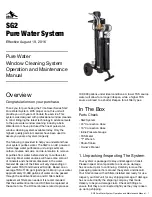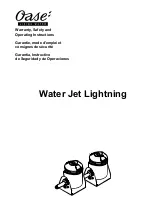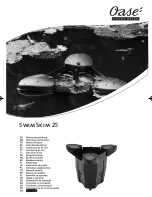
180R9346 | AQ240486503020en-001702 | 107
© Danfoss | 2023.03
Operation guide
Installation, Operation and Maintenance APP 53-92 pumps
Cause
Remedy
Comments
3.4 Water pump damage
3.4.1 Dismantle pump and check for wear.
Too heavy damage in the pump will increase
friction causing a high torque (see item 6,
Typical signs of wear).
4.1 Air in fluid
4.1.1 Ensure that the entire inlet line is bled
before starting up the system.
4.1.2 Ensure that air cannot enter into the inlet
line.
Small air bubbles will accumulate and create
large bubbles causing internal cavitation and
thus making the pump very noisy.
WARNING:
The pump can only run few minutes with air
in
the fluid without being damaged.
4.2 Bleeding conditions of pump
4.2.1 Follow the instructions “Initial start-up”
supplied with the new pump.
4.2.2 Ensure that the pump is completely bled
before start-up.
The pump and the inlet line must be com-
pletely bled before start-up, otherwise the
pump will cavitate and make high noise.
WARNING:
The pump can only run few minutes with air
in the fluid without being damaged.
4.3 Min/max nominal inlet pressure
4.3.1 Ensure that inlet pressure is within the
limits specified in the User manual.
4.3.2 Check the pump for internal damage.
Too high inlet pressure causes too high
pressure inside the pump damaging the pistons
and eventually the pump.
Inlet pressure below min. limit causes
cavitation and insufficient internal lubrication
resulting in wear on internal pump parts.
Mount a low-pressure switch in front of the
pump and check its set point/ function. The
low-pressure switch will ensure that the pump
does not start until the min. inlet pressure has
been reached.
4.4 Pump reversing
4.4.1 Dismantle pump and check if anything is
broken or worn (See “1. No flow”, item 1.2
Pump reversing”).
WARNING:
The pump must not run without water
for more than a few seconds. If the pump
takes in water from the high-pressure
outlet line, it builds up pressure and will
eventually be damaged.
If pump rotates in wrong direction, it will take
in water from the high-pressure outlet line.
Pressure will be built up inside the pump and it
will eventually be damaged.
4.5 High rotation speed (rpm)
4.5.1 If electric motor rpm is too high, dismantle
pump and check for damage.
4.5.2 If the rpm is within the specified range of
the pump data sheet and abnormal noise
remains, dismantle pump and check for
damage.
Higher rpm than specified in the pump data
sheet results in wear of the pistons, i.e. pistons
may be damaged.
High rpm will also increase pressure pulsations
from the pump, and the noise level will
increase.
If rpm is changed, noise frequency will also
change.
4.6 Outlet pressure
4.6.1 If outlet pressure is too low, check set
point of outlet pressure valve.
4.6.2 If outlet pressure is lower than mentioned
in the pump data sheet, please contact
Danfoss High Pressure Pumps technical
support.
4.6.3 If outlet pressure has exceeded its
maximum, check set point of outlet
pressure valve.
4.6.4 Check internal parts for wear/damage.
At too low outlet pressure, the pump will create
higher pressure pulsations and thus make
noise. Too low pressure also causes insufficient
internal lubrication and wear on internal parts.
Pump may eventually be damaged.
Too high outlet pressure may damage the
pump.
4.7 Soft start/stop
4.7.1 Check if noise is normal when the pump is
running at operation speed.
4.7.2 If noise is abnormal at operation speed,
check internal parts (see above).
Noise frequency changes during soft start-up/
stop.
4.
Noise from pump












































